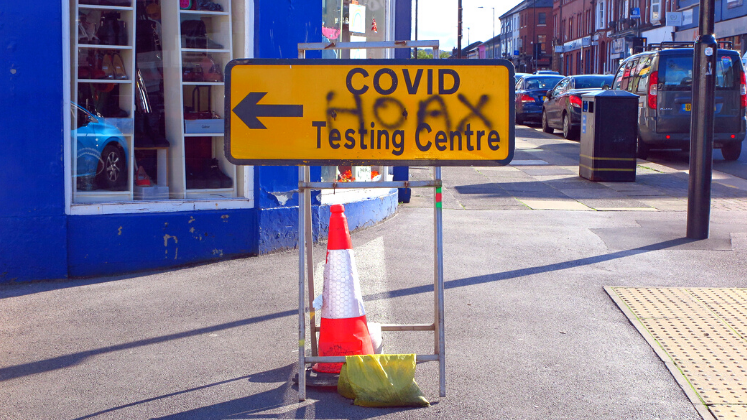Narratives and Evidence – Which stories about COVID-19 did we believe and why?

Eivind Engebretsen, Mona Baker
LSE Impact Blog, 25 May 2022
Rigorous empirical evidence is often presumed to be the most persuasive, notably in fields such as healthcare and medicine, where there are established frameworks for assessing the quality of evidence. In this post, Eivind Engebretsen and Mona Baker argue for the importance of narrative rationality, especially in areas where expertise is contested. Drawing on work from their forthcoming book and taking the COVID-19 pandemic as an exemplary case, they point to how the narrative structure and context of evidence are closely related to how knowledge is communicated and adopted by different audiences.
In April 2020, Aljazeera reported that thousands of street vendors in Malawi marched with banners featuring statements such as: ‘Lockdown more poisonous than corona’ and ‘We’d rather die of corona than of hunger’. Civil rights organizations applied for a court order to stop the government implementing the lockdown, citing “the government’s failure to announce any measures to cushion the poor”. To these people, in this context, it did not make sense to ‘follow the science’.
In a blog post titled ‘Wearing a face mask helps protect me against COVID-19, but not against racism’, a black physician in Boston raises the issue of how mandatory face masks might affect people of colour. Although he acknowledges that wearing a facemask would help reduce the transmission of coronavirus infections, he often opted not to wear one knowing that “some people will see a masked Black man as a threat”. This might sound irrational to some, but it resonates with stories that are far too familiar to many Black people.
These and similar stories can only be assessed on the basis of the specific values people adhere to and invest in their narratives. Moreover, scientific claims are themselves narratives, and whatever their factual status, they are ultimately assessed on the basis of people’s lived experience and the values they hold most dear.
Appraising facts and stories
Central to disentangling these issues is Walter Fisher’s narrative paradigm, the basic premise of which is that “[n]o matter how strictly a case is argued – scientifically, philosophically, or legally – it will always be a story, an interpretation of some aspect of the world that is historically and culturally grounded and shaped by human personality” (1987: 49). There is no story, however scientific, that ends all storytelling. And there is no story, however well supported by ‘facts’, that is not ultimately evaluated in the context of a life lived with others.
application of the narrative paradigm challenges the prevalent understanding of evidence that underpins evidence-based medicine (EBM)
Whilst for some, such observations may seem mundane, our application of the narrative paradigm challenges the prevalent understanding of evidence that underpins evidence-based medicine (EBM). EBM emerged in the 1990s and has contributed to promoting an understanding of evidence as a singular phenomenon that can be ranked on a singular scale. Indeed, EBM has developed just such a framework for ranking evidence in a hierarchy that features simple observational methods at the bottom and moves on to increasingly rigorous methodologies, with randomised controlled trials (RCTs) and systematic reviews of such trials at the top of the evidence pyramid. Although this hierarchy has been criticised and modified, a dominant assumption among EBM advocates is still that findings generated by RCTs are likely to be “closer to the true effect than the findings generated by other research methods”.

Epistemologically, this hierarchy relies on observations (empiricism) as the method of knowing; ontologically, it conceives of reality as a set of causal mechanisms (realism). But as the COVID-19 crisis clearly illustrates, there are many sites of knowledge construction in medicine – let alone other spheres of practice – where these rules do not apply. Consider the controversy reported in The New York Times in August 2020 under the title ‘The Covid Drug Wars that Pitted Doctor vs Doctor’. The report revealed that even physicians who had been committed to relying on evidence from randomised controlled trials, according to colleagues, wanted access to all types of unproven medicines when it was their mother fighting for her life. For decisions that directly affect us or our loved ones, scientific evidence may be largely overridden by other considerations, even for those who would otherwise appeal to it as the only rational basis for decision making.
In this respect, EBM fails to acknowledge that the way different groups engage in the process of knowing determines the principles and objects of their knowledge. In contrast, the narrative paradigm provides better explanations for how people conceptualise and evaluate evidence, whilst recognising that ‘human beings are as much valuing as they are reasoning beings’ (1997:314). In outlining and extending this framework, we seek not only to interrogate current, restricted conceptualisations of evidence in the EBM model, but also to elaborate a more nuanced and socially responsive approach to expertise in general.
Plausible stories are ‘true to life’
One of Fisher’s key insights is that in any communicative encounter – whether it involves a scientific theory, a fictional story, or a factual account – our engagements with evidence are assessed not by resort to logical inference, but on the basis of what he calls ‘good reasons’. The two principles that define narrative rationality and embody the logic of good reasons in Fisher’s paradigm are narrative probability and narrative fidelity. These may be thought of as tests that we apply to decide whether a narrative offers good reasons for action and belief.
The first test asks whether the story ‘hangs together’. In the context of the pandemic, it isn’t difficult to find stories that don’t. Within the space of nine months, advice issued by the WHO changed from warning against the risk of community masking, to encouraging its use. Yet, the theory underpinning the advice was never corrected. Fisher would consider this as evidence of incoherence in the organisation’s practice of evidencing; its story doesn’t hang together.
Ultimately, it is through narratives that knowledge about medical and other phenomena is communicated to others and enters the public sphere.
The second, and more important test, involves assessing whether the story has ‘truth-qualities’ and ‘rings true’ to its recipient(s). Fidelity does not require the audience to actually share the experiences of protagonists, such as black populations, or their reasons for hesitating to wear face masks in public. It merely requires that these protagonists’ experiences appear to the audience to be ‘true to life – in principle’. Even a fictional story can be ‘true to life – in principle’ in the sense of accounting for experiences that seem real or credible ‘given the universe in which the characters live and the logic of their story’.
To return to the issue of mask wearing during the COVID-19 pandemic, narrative theory shows how: On the one hand, these arguments could be vocally rejected by some on the basis that mask mandates encroached on their personal freedom and were a form of control over their bodies; whilst at the same time, others accepted the mandates willingly and saw compliance with them as a matter of moral responsibility to protect themselves and others. Neither group can simply be dismissed as irrational. In both cases, the worth of the story is assessed on the basis of “good reasons”.
Ultimately, it is through narratives that knowledge about medical and other phenomena is communicated to others and enters the public sphere. Pandemics in general, and COVID-19 in particular, are emblematic sites for exploring and challenging concepts of evidence, because they clearly transform such concepts into a topic of public concern and demonstrate the relevance and urgency of engaging with the processes by which they come to be understood and assessed differently by various constituencies. The narrative paradigm provides us with a nuanced perspective on why people arrive at different decisions based on the same sources of evidence, and encourages us to acknowledge their reasons for doing so as rooted in different types of rationality, rather than dismissing them as irrational.
Engebretsen, E. Baker M. Rethinking Evidence in the Time of Pandemics: Scientific vs Narrative Rationality and Medical Knowledge Practices. Cambridge: Cambridge University Press; 2022 (in press)
The content generated on this blog is for information purposes only. This Article gives the views and opinions of the authors and does not reflect the views and opinions of the Impact of Social Science blog (the blog), nor of the London School of Economics and Political Science. Please review our comments policy if you have any concerns on posting a comment below.
Image Credit: Tim Dennell, Coronavirus (COVID-19) Sheffield, UK, via Flickr (CC BY-NC 2.0)
About the authors
Narratives and Evidence – Which stories about COVID-19 did we believe and why?